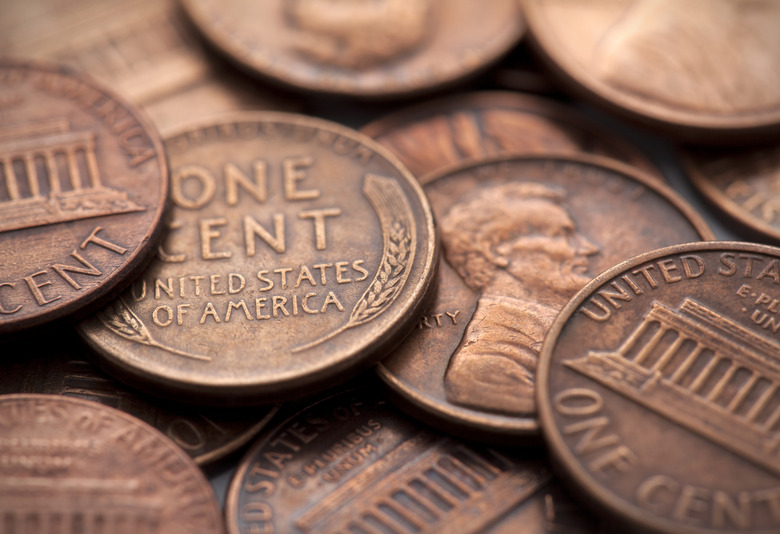Why Do Pennies Corrode?
If you look at a penny, it appears to be copper, but unless it's a very old one, it's actually a combination of metals that may include copper, zinc, tin, nickel or steel. Whether or not your penny contains other metals, though, the surface is almost always copper, and exposure to the atmosphere turns that metal turns dull. One reason that pennies contain zinc is because that metal has a high resistance to atmospheric corrosion.
Historic Composition of Pennies
Historic Composition of Pennies
The United States Mint began producing pennies in 1793, and until 1837, the coin was 100 percent copper. From 1837 to 1857, the penny was bronze — it contained 95 percent copper and 5 percent zinc and tin. In 1857, the Mint began producing pennies with 12 percent nickel and 88 percent copper that had a whitish appearance. Production of bronze pennies resumed in 1864, and the composition remained unchanged until 1962, when the tin was removed, leaving 95 percent copper and 5 percent zinc. In 1982, the Mint stopped producing copper pennies and began producing copper-plated zinc pennies with a a composition of 97.5 percent zinc and 2.5 percent copper. Most pennies produced in 1943 were steel in an effort to conserve copper for the war effort.
Corrosion of Copper in the Atmosphere
Corrosion of Copper in the Atmosphere
The copper in a penny, whether it forms the bulk of the coin or merely a surface layer, turns dull when exposed to the air. The reason is that copper atoms combine with oxygen molecules to form copper oxide, in a chemical process called oxidation. In the simple reaction, each of the oxygen atoms in an oxygen molecule combines with a copper atom, and the result is two molecules of copper oxide. When oxidation occurs with iron, the result is called rust. A penny with a high copper content won't disintegrate in air, because once a surface layer of copper oxide forms it prevents further corrosion.
Galvanic Cell Reaction
Galvanic Cell Reaction
Zinc is a transition metal that resists rust, and it is often used to coat other metals to prevent them corroding — a process called galvanizing. Alloys of copper and zinc are called brass, and they have been used since ancient times. When copper and zinc are separated by a distinct layer, however, as they are in newer pennies, a galvanic cell reaction can occur in salt water that hastens corrosion. This reaction is the same one that corrodes copper pipes joined to galvanized steel ones without a dielectric coupling. It's caused by electricity, which is more easily conducted in salt water than in air.
Cleaning Pennies
Cleaning Pennies
It isn't difficult to clean dull pennies. All you have to do is immerse them in a solution if water, vinegar and salt. The acetic acid in vinegar that dissolves copper oxide, and adding salt speeds up the process. Corroded pennies usually turn bright again in less than a minute. You can get similar results using lemon juice, which contains citric acid. If you remove a penny from this solution and leave it on a table without drying it off, it will form a green coating. This is malachite, a salt of copper.
Cite This Article
MLA
Deziel, Chris. "Why Do Pennies Corrode?" sciencing.com, https://www.sciencing.com/do-pennies-corrode-5133409/. 24 April 2017.
APA
Deziel, Chris. (2017, April 24). Why Do Pennies Corrode?. sciencing.com. Retrieved from https://www.sciencing.com/do-pennies-corrode-5133409/
Chicago
Deziel, Chris. Why Do Pennies Corrode? last modified March 24, 2022. https://www.sciencing.com/do-pennies-corrode-5133409/
